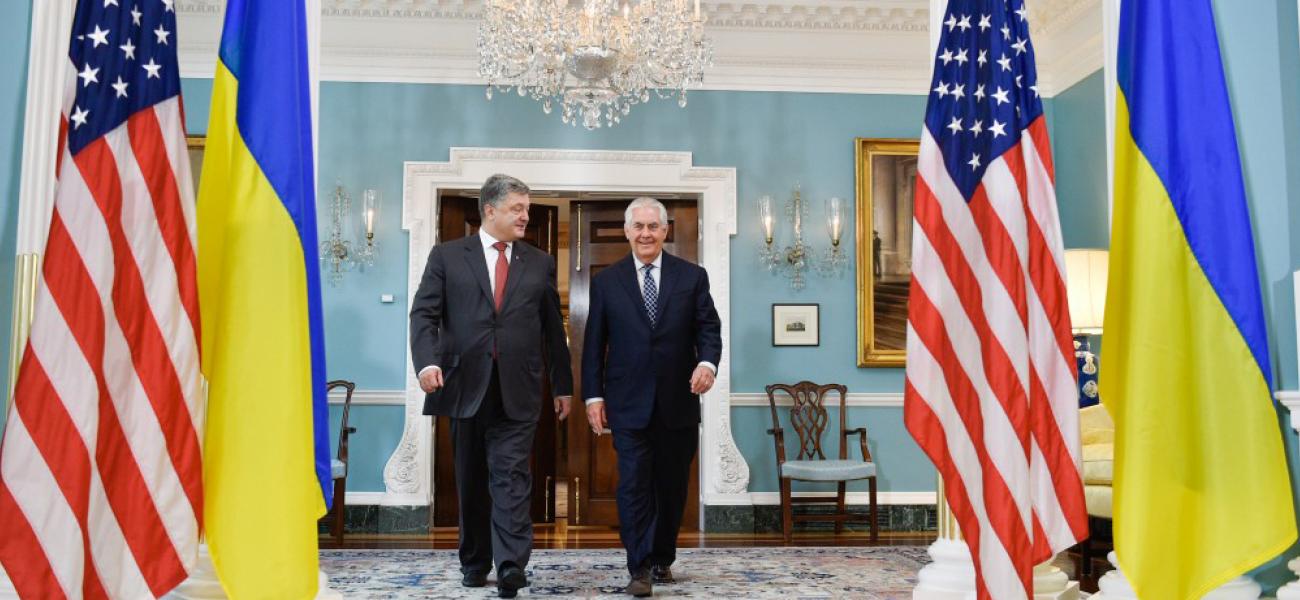
Survey on Ukraine: Does Providing Lethal Weapons to Kiev Serve US Vital Interests?
U.S. Defense Secretary James Mattis will make his first official visit to Ukraine as on Thursday, the country’s Independence Day, amid reports that the Trump administration is considering whether to approve a plan to give Ukraine lethal weaponry, including anti-tank Javelin missiles, as well as anti-aircraft missiles that the Pentagon and the State Department have reportedly approved. Ukrainian President Petro Poroshenko has stated ahead of Mattis’ visit that he expects the U.S. and Ukraine to sign a number of defense cooperation agreements soon.
Providing lethal military aid to Ukraine, as its standoff with Russia-backed separatists in the east of the country continues, has prompted considerable debate in policy circles. We have asked five experts to weigh in. Are vital U.S. interests at stake here? Would arming the Ukrainians further these interests, and how might this impact America’s relationship with Russia? While each expert took their own approach and emphasized certain policy priorities over others, all but one did agree on at least one point: The U.S. should refrain from supplying lethal weapons to Ukraine.
Question 1: What U.S. vital interests are at stake in the conflict in eastern Ukraine?

Kevin Ryan
Associate Fellow, Belfer Center for Science and International Affairs, Harvard Kennedy SchoolAt first glance, the situation in Ukraine may appear to have little impact on vital American interests. Ukraine is far from the United States, and the U.S. has a relatively small economic and military connection to the country. But seen in the context of a Russia that is trying to expand its control of neighboring states, the situation in Ukraine is a new level of assault. Since the mid-1990s, Russia has sought to reverse its losses at the end of the Cold War. Russia has broken off two regions from Georgia (Abkhazia and South Ossetia); meddled in Moldovan, Ukrainian and Montenegrin politics; conducted cyberattacks in the Baltics and threatened more. The occupation of Crimea and fighting in eastern Ukraine are the latest in a string of escalating assaults against neighboring states. This is an issue of vital interest to the U.S. in line with its longstanding position that war in Europe will eventually require its involvement.

Olga Oliker
Director, Russia and Eurasia Program, Center for Strategic and International StudiesIf Washington cares about Europe and/or maintaining at least some of the basic tenets of the post-Cold War order it helped build, it cares about Ukraine, its security, and an end to the war in the Donbas.

Michael Kofman
Senior Research Scientist, CNA Corporation; Global Fellow, Kennan Institute, Woodrow Wilson International CenterThe United States wants to see Ukraine succeed as a democratic country and become a productive member of the European community. The U.S. also has an interest in making sure that Russia does not get away with redrawing borders on the continent through use of force. Perhaps more paramount is the need to freeze the current conflict, rather than permit a destabilizing war in Europe that will undoubtedly affect American allies on the continent. The conflict should also be viewed as a challenge to rules in the international order that the U.S. seeks to maintain, in particular those designed to check the revisionist behavior of other powers. Hence, U.S. policy should be underpinned by helping Ukraine become successful, stabilizing the current conflict, and imposing costs on Russia. That said, there are no “vital” interests at stake in Ukraine for the U.S., because “vital” is an exceedingly high bar to meet in policy terms – most of Washington’s foreign policy pursuits won’t meet this standard.

Nikolas Gvosdev
Professor of National Security Studies, U.S. Naval War CollegeThe theory behind weapons shipments — and what United States interests they are supposed to serve – is that advanced U.S. arms will help the Ukrainian military counterbalance better-equipped Russian forces and their proxies, deterring Moscow from further advances that might collapse a Ukrainian state now serving as a buffer separating Russia from new NATO allies in Central Europe. It would also belatedly redeem the failure of the U.S. to take more decisive action to sustain the 1994 Budapest Memorandum, a largely non-binding commitment to preserve Ukraine’s territorial integrity after it gave up its Soviet-era nuclear weapons. It assumes that the Ukrainian government has made sufficient progress in rooting out the corruption that hollowed out Ukraine’s army for two decades – so that U.S. weapons don’t end up on the black market. And it assumes that a better-equipped Ukraine will be more likely to negotiate the final status of the separatist areas from a position of confidence – rather than emulate then Georgian President Mikheil Saakashvili’s reckless gamble in 2008 that he could retake separatist areas before Russia would have time to react. It also hopes that the provision of U.S. weaponry to Ukraine – a step that has been strenuously opposed by America’s principal NATO allies – will not, alongside new U.S. sanctions, end up provoking strains in the trans-Atlantic relationship.
The United States has had a mixed track record in its security assistance programs in recent years – the rout of an American-trained and equipped Iraqi army in the face of an ISIS onslaught in 2014 and the difficulties in creating any sort of credible “moderate” Syrian opposition force being two prominent examples of failure.

Mathew Burrows
Director, Strategic Foresight Initiative, Atlantic CouncilIt’s in the United States’ interest that a peaceful settlement be reached between Ukraine and Russia, ending the conflict in eastern Ukraine and eliminating it as a thorn in ongoing U.S.-Russian relations. Without a negotiated and peaceful resolution in Ukraine, it’s unlikely that bilateral relations can be improved or normalized. A further deterioration in the conflict will increase calls from U.S. hawks to help Ukraine, further exacerbating relations with Russia. Moreover, a sort of “proxy” war in which the U.S. and other Western partners actively aid Ukraine’s efforts to militarily subdue separatist forces in the Donbas could ramp up tensions with Moscow to a very dangerous level, possibly even leading to open conflict.
Question 2: Bearing these interests in mind, what would be your top recommendations for U.S. policy toward Ukraine in the short-to-medium term?
Kevin Ryan
As a result of the Russian invasion into parts of Ukraine, the U.S. has provided defense aid in the form of training and so-called “non-lethal” equipment. Under consideration now in Congress are calls to allow “lethal” military aid, considered to be weapons and ammunition that can be used in offensive operations. While Ukraine can produce much of what it needs militarily, or could certainly buy needed weapons abroad, the U.S. can make a strong statement against Russian aggression by helping Ukraine with weapons and ammunition. Such a step, after several years of patient restraint, would demonstrate that the U.S does not view the status quo in Ukraine as acceptable.
In addition to providing lethal aid to Ukraine, the U.S. should continue to increase its military capabilities in the Baltic states, making clear the connection between our support of NATO countries and our support of Ukraine. Increasing our capabilities does not have to mean larger troop numbers, but it can mean bolstering training preparedness, equipment and stockpiles in the region.
Olga Oliker
What can the United States do to help make Ukraine secure and stable? It must, first and foremost, hold the Ukrainian government accountable. The only real way to guarantee Ukraine’s security is to fulfill the promise of the Maidan. Disturbingly, Ukraine's progress on reform has been highly correlated with Western conditionality – Ukraine does what it must to keep the aid flowing. In the security sector, as in many others, the Poroshenko administration has developed reform plans but is not implementing them. Meanwhile, in areas like fighting corruption and free speech, we have seen disturbing turnarounds. This suggests that unconditional support for Ukraine will lead to both Ukrainian failure and Western entanglement: the worst of both worlds.
One component of smart, conditional assistance is keeping pressure on Ukraine to plan for the future of the Donbas. The continuing war not only provides excuses to avoid reform, it hardens positions. Today, it’s not entirely clear if Ukraine’s leaders really want the Donbas back, even as their soldiers fight for it. This creates disincentives to seek political solutions and hands Russia the victory of an unstable Ukraine. If Washington wants Ukraine to be successful, it must help it lay the groundwork for unity and reconciliation.
Michael Kofman
1.) Continue to provide Ukraine access to capital contingent on further reforms. 2.) Encourage Ukraine, but don’t be a cheerleader. Ukraine's leaders can't be allowed to feel that the U.S. will support them no matter what, because then the country could easily backslide – and we know what that Ukraine looks like. Ukrainians have to want this for themselves. 3.) Support Ukraine's defense industry and military reforms by providing access to Western components, training its armed forces, and encouraging Kiev to professionalize the military. American policymakers struggle thinking long-term, but helping Ukraine is principally a long-term proposition. 4.) Negotiate with Russia and Ukraine to freeze the current conflict. In terms of implementation, the Minsk Agreement is dead and exists in name only. Washington made an error in judgment by allowing Europeans to take the lead on handling this issue with Russia, and this approach has run its course. 5.) Settle in for the long haul and look for incremental improvements rather than setting idealistic expectations. Encourage Ukraine's integration into Europe, but don't make promises and political statements that the U.S. can't and won't substantiate. Understand the limitations of American power and influence – and don't expend them thoughtlessly.
Nikolas Gvosdev
Taking on greater role in Ukraine requires the U.S. to step back and consider how to match what outcomes it wants to see in the country with what resources and risks it is willing to commit. Realistically, the U.S. cannot change the realities of Ukrainian geography or demography, but targeted U.S. assistance – as well as maintaining lines of dialogue with both Moscow and our critical European partners, could work to strengthen Ukraine’s position as an independent, non-aligned state, restoring its critical geo-economic linkages between Russia (and a rising China) with the Euro-Atlantic world, and paving the way for political settlements that would settle the country’s territorial integrity while moving Ukraine beyond the east-west pendulum that has so paralyzed its political life for the past 20 years.
The critical gamble, of course, is that Russia will remain quiescent for the three years that the proposed training calendar assumes are needed for a new Ukrainian military to be in place. With Russia already moving ahead to complete its pipeline projects needed to end use of Ukraine as a transit country and to accelerate efforts to find replacements for the Ukrainian goods and services that it needed – particularly in the defense industry – the likelihood increases that during the “gap year” of 2019 – before Ukraine’s military reform and rearmament is complete – Moscow will make its move to destabilize Ukraine a third time. Unless, that is, U.S. diplomacy is more successful than that of its European counterparts in producing a lasting political settlement.
Mathew Burrows
- Bolster Minsk talks, perhaps with a stronger U.S. component.
- Encourage Kiev to focus on internal anti-corruption reforms.
- Urge Kiev to give up on the idea of NATO membership.
- Urge Kiev to open back channels to Moscow.
- Encourage Kiev to work with the IMF and World Bank on enticing foreign direct investment.
- The more that Ukraine is an economic and political success, the more it can assure its independence from Russia. Focusing on a military contest will only undermine Ukraine’s recovery.
Question 3: Do you think that delivering the kind of lethal weaponry described above to Ukraine will impact U.S. vital interests, and if so, how? When assessing the overall impact, should the U.S. factor in Russia’s reaction, and if so, what might this reaction look like?
Kevin Ryan
Russia will certainly react to these steps by the U.S., and Washington should respond accordingly. But for U.S. deterrence to be credible in Europe, it must be more than words. There are many political and economic changes that Ukraine needs to pursue to survive the current troubles, and the U.S. should be a key supporter in those efforts. But a strong and unambiguous stand in support of Ukraine's security (alongside a similar stand in the Baltics) is key to restraining Russian adventurism.
Olga Oliker
In my opinion, lethal aid would be counterproductive, and thus out of line with U.S interests, for three reasons:
First, Javelin will not deter Russia. Russia has escalation dominance – it can put more into the fight if it wishes, as it has shown time and again. American anti-tank weapons won’t change that. Instead, their delivery will lead to Russian counter-escalation, and will worsen, not resolve, the conflict.
Relatedly, and second, lethal weapons would not arrive right away, and Ukrainian troops would need training to use them. In the interim, Russia would have an incentive to counter-escalate quickly to get more bang for its ruble.
Third, Ukrainian chain-of-custody presents its own problems. While Ukraine’s logistics system has improved, there is still cause for concern that weapons will be diverted or misused.
This said, I am very much for (conditional) security assistance to Ukraine. But rather than seeking to score political points with lethal aid, Washington should do a better job helping Ukrainian soldiers. The dirty secret of assistance to date is not that the wrong things are provided (though this also happens), but that aid is too small and too slow, however useful some components (like counter-battery radars) may be. For example, secure communications has been a continuing problem. But while Ukraine has received radios from the West, they are limited in number, and not always interoperable.
An informed, conditional and focused assistance program for Ukraine could make a real difference in the security sector and beyond, if it is aligned with Ukraine’s needs and designed to ensure the country stays on a path to reform.
Michael Kofman
Giving Ukraine weapons is electing to make the current conflict a function of U.S. foreign policy, i.e. turning it into a proxy war with Russia. It should only be done as part of a broader strategy and policy to deal with Russia, recognizing that Moscow can prove a powerful spoiler and will likely retaliate elsewhere against U.S. interests. To think otherwise is to engage in idealistic self-delusion. This is not just a policy question about Ukraine, but rather about geopolitical confrontation with Russia. Here policymakers should think first and foremost about the U.S. national interest and whether arming Ukraine is a sound decision given the potential costs and impact on the conflict. It's also quite unclear where key U.S. allies stand on this issue and whether such a decision is part of a coordinated strategy to manage the conflict.
It's difficult to see arming Ukraine having positive outcomes for U.S. interests – and at this stage of the conflict, it’s a rather untimely proposition. The arguments for arming Ukraine with anti-tank missiles are weak, and make little sense given the nature of the conflict. Few countries that host proxy wars are ever better off for it. The latest example was America’s rather half-hearted arming of the Syrian opposition with no strategy, which ultimately resulted in their defeat. This is the problem with just sending weapons and hoping for the best. Arming people fighting for their freedom is a good slogan, but slogans make for terrible strategies, and they often end in failure. So far there’s no visible Russia policy, or strategy for handling the conflict in Ukraine, that would substantiate this decision as part of a coherent approach to either problem. If the U.S. is serious about solving something, it will not seek to needlessly meddle in the conflict without having thought through the strategic implications; instead, it will try to help in more meaningful ways.
Nikolas Gvosdev
On their own, U.S. weapons shipped in crates to Ukraine will not be talismans capable of magically changing the situation on the ground but have to be carefully integrated into a larger strategy where the U.S., instead of minimizing its direct involvement – as it has for the last three years – commits to playing a much greater role in helping to rebuild Ukraine’s security sector, the risks of which Washington may not be willing to bear.
Mathew Burrows
Delivery of lethal weaponry undermines U.S. interests because it escalates tensions between Russia and the U.S., as well as with Ukraine. It does not serve any military purpose, and it could lead to a dangerous escalation in U.S.-Russian tension. It raises faulty expectations on Ukraine’s part that the U.S. will come to its assistance in a big way in case of Russian aggression. In the end, the Trump Administration is likely to hold back from a proxy war, although there’s always the risk of miscalculation on both sides. Finally, the delivery of lethal weaponry detracts from the strong message the U.S. should be sending to Ukraine on economic reform.
The opinions expressed in this commentary are solely those of the author.
